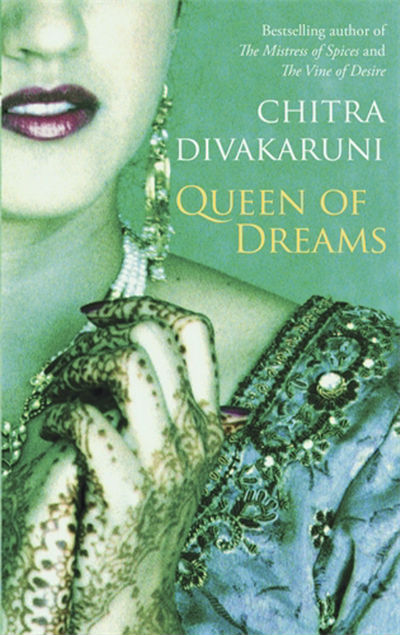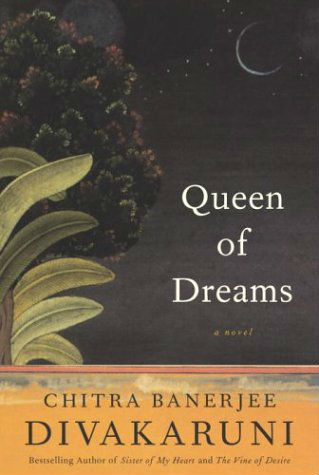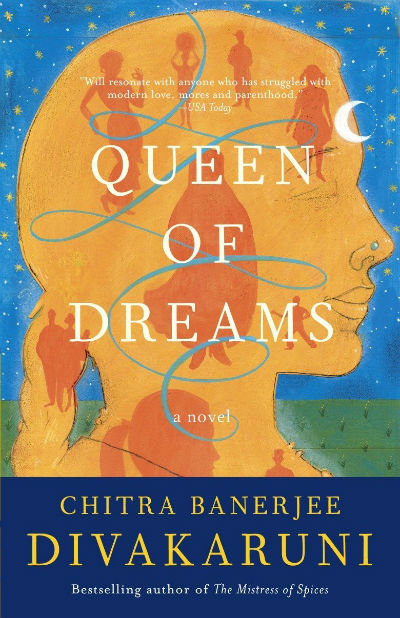Most readers know Chitra Banerjee Divakaruni for her popular novel Mistress of Spices and its movie version starring Aishwarya Rai. While it was one of her earlier bestsellers, she has published a fair few of them over the years, and we have been exploring these tales and we have shared our views on her collection of short stories Arranged Marriage previously on this blog.
Considering one of the best features of Mistress of Spices was its surreal setting that combined the magical power of East with the sub-stories of immigrants trying to build a life in America, I think in some ways that also must have inspired the book we are talking about today: Queen of Dreams.
| Book Title | : | Queen of Dreams |
| Author | : | Chitra Banerjee Divakaruni |
| Publishers | : |
Little, Brown Book Group (3 November 2005) Doubleday (14 September 2004) |
| # of Pages | : |
320 (Paperback) 352 (Hardcover) |
| # of Chapters | : | |
| Purchase Link(s) | : |
Instead of an island of spices, it is the dream-tellers living in the caves… Here are the elders who teach young women how the world of dreams work with its intricate web-work. As the Queen of dreams herself says in the book:
I dream the dreams of other people, so I can help them live their lives…
We read an old paperback edition, published by Abacus in December 2005. The cover page features the hues of turquoise and blue with half a face of a beautiful woman ornamented and painted, her hands decorated with Mehandi…

Queen of Dreams by Chitra Banerjee Divakaruni | Book Cover
The cover page was probably targeted to the overseas audience and has now been replaced with a cover page showing a side profile of a woman’s face with a half moon on the forehead. In our opinion, this cover page could use a bit of re-designing to show the canvas of modern day America overlapped with the dreamy world of caves where women learn to interpret subconscious.
This Is Here In For You
Storyline:
Being a poetic tale of dreams, the book starts with an excerpt of a dream journal where the Queen of Dreams dreams of the Serpent, herald of the death in this dream. As the book continues, we learn of her story through these pages from her dream journals. And so do her family, her husband and her daughter Rakhi.
You could say that this is the story of Rakhi. We live her life as she tries to balance her work as a painter, a divorced single motherhood with a shared custody of her daughter Jonaki, and her partnership in the Chai House with her best friend Balwant Kaur aka Belle.
Since her childhood, Rakhi had idolized her mother, desperately coveted her ability to interpret dreams, and when it was clear that she didn’t have the same gift, had tried her best to know the enigmatic woman she was closest to and farthest from, on this earth. But, wanting something is no guarantee to achieve it, and in spite of the love between them, the relationship still remains strained.
Same goes for her love-life and marriage with Sonny. They met at the University, loved each other’s art and each other, gotten married and had a daughter, in what felt like a fairy tale to Rakhi’s sheltered existence. She had the husband who she thought would always take care of her and the domestic bliss will continue forever. This, however, not to be. And now they are divorced, but it is far from over. Sonny still has the capability to bring the worst out in Rakhi’s nature, and neither of them has really moved on.
But she is incredibly lucky to have a friend like Belle. The partnership in the Chai house is Rakhi’s only means to financial stability and reason to be able to have shared custody of Jonaki. And so when a very successful coffee chain opens a franchise across the road and takes their business away, Belle and Rakhi turn to Rakhi’s mother for help and guidance. While she does give them a hint, she hardly can provide a readymade solution.
Things appear to improve though, as Rakhi’s first exhibition of paintings come through. The evening starts on a good note, but soon turns into a public fight between Rakhi And sonny and the nights ends up in a tragedy as her mother dies in an accident, while driving home from the exhibition.
Rakhi spirals into a vortex of what appears to be unending problems – unresolved issues with her mother who is far beyond the answers, anger at her father for surviving while her mother died, failing business, frayed relationship with her daughter.
Help comes from an unexpected quarter as she starts to know her father as a person, only to be short-lived as a much bigger tragedy strikes America in the form of the terrorist attack of nine-eleven.
All their lives are turned upside down, as they suddenly become aliens in the only country they have ever known…
Will they ever find the lost pieces of their lives and make it whole again?
It is, by all means, a beautiful tale, and easy to read even with the interweaving threads from different narrators. It has the right blending of looking back into the mother’s past and the daughter’s present. The story is like a gift box wrapped with multiple layers and with each chapter you unwrap another layer, learn a little bit more about the characters and their inner worlds – their thoughts, their dilemmas, their wishes and their dreams…

Queen of Dreams by Chitra Banerjee Divakaruni | Book Cover
The world of dreams that the Mother inhibits, with the knowledge she gained from the elders and the books like Brihat Swapna Sarita and Swapna Purana, brings her the signs and the warnings about lives of strangers. People find her to interpret their dreams, to help them and although she defies the elders by leaving the caves, taking a husband, making a family, she cannot escape her identity as a dream-teller. And when it comes to the final choice, she realizes she doesn’t have any. Gifts and powers like this are so inherent in the soul, that she can hardly give them up and be able to live with herself.
But most gifts are also a burden, whether it is the foreknowledge of tragedies, or the responsibilities of warning people in time or on a very personal level, being forced to make a choice. Like most of us, her choices are also driven by love – or how a young girl thinks of love – until she lives through the choices and finds that we don’t really always even have the freedom of choice. We see her journey on the path of love as she goes from
If love is strong and pure, it can overcome all barriers…
to
The best way to love people is not to need them. That’s the purest love…
and
Those you love the most, you’ll help the least…
We all fall in love with an image of a person, but as we learn about them, the feelings change. It is like not knowing is the only way it is possible to love? and there is no escaping the transient nature of it…
Each of us lives in a separate universe, one we have dreamed into being. We love people when their dream coincides with ours, the way two cutout designs laid one on top of the other might match. But dream worlds are not static like cutouts; sooner or later they change shape, leading to misunderstanding, loneliness and loss of love..
And although it is the internal, magical world that draws you in, you also have to surface out of it to live through the modern world, with its commonplace tragedies and feel for all the characters as they battle through them – Rakhi, Sonny, Jonaki, Belle, Jespal, Rakhi’s father. None of them seem to have terrible gifts and terrible burdens. They have their talents like painting, music, cooking, but nothing as onerous. They face failures, hatred, jealousy, misunderstandings just like we all do, trying to grow up and find the place in their surroundings that fit them.
The author weaves in the juxtapositions about their reality very deftly through their musings about events happening around them, e.g., when Rakhi and Belle visit their competition across the street, to see why people will go for a coffee there, Rakhi realises that sometimes we all need just a bit of anonymity, a place where no one knows us:
This place demanded nothing of the except their money. It allowed them to remain unknown. No conversation, no contact, nothing to look at or discuss, nothing of themselves exchanged or exhaled. And yet they have community, too, as much of it as they want: the comfortable company of a roomful of nameless, faceless folks just like themselves, happy to be left alone, to gaze into the middle distance, to notice no one.
It is through the conversations and dialogues, that we know the young characters – Rakhi, Belle, Sonny, Jespal – second generation Americans have different ways to cope with their upbringing by Indian immigrant parents living in America. While Rakhi’s mother has tried to keep her away from their past in India, Belle’s parents have tried to bring her up with Indian values. But, neither set of parents seem to have found the perfect solution as Rakhi pines for Indian stories and belle has denounced most Indian values.
As Rakhi’s mother says:
I thought I would protect you if I didn’t talk about the past. That way you wouldn’t be constantly looking back, hankering, like so many immigrants do. I didn’t want to split you between here and there, between your life right now and that which can never be…But by not telling you about it, I made it something far bigger than it should be…
Rakhi’s longings to know about India, her inclination to paint Indian landscapes, opening a chai house, these are all symbols of how we all feel about having roots, wanting to belong. And although she sees herself as completely American, in light of the 9/11 tragedy, other Americans are very quick to take away that sense of belonging from the dark skinned, dark-haired women and turban wearing Jespal, who has found his comfort as being the Sikh, after battling with it as he grew up. There is a deep sense of injustice here as their country appears to deny people to exist as whatever they want to be. They have just entered the nightmare that will have no happy ending any time soon…
And in spite of all these, there is a sense of ending when we leave the characters – not a happily ever after – but more of a step taken forward in search of the self – ending. While we have seen Rakhi and her loved ones battle through the time we spend with them, we somehow leave with a feeling that they’ll survive and eventually will also find a sliver of happiness…

Queen of Dreams by Chitra Banerjee Divakaruni | Book Cover
We enjoyed the book, both for its day to day characters as well as the world of dreams, and especially quotes like below which mirror our own love for the written word and the ability it takes to convert thoughts and memories into stories:
Each thinking of a story differently, as teller and listener always must. In the mind of each, different images swirl up and fall away, and each holds on to a different part of the story, thinking it is the most important. And if each were to speak of what it meant, they would say things so different you would not know it was the same story they were speaking of…
— —- — —- — —-
For the written word is different from spoken. The spoken word vanishes, frost in sunshine. The written word endures, its black frieze like ironwork in palace windows. But I am hampered by my lack of craft. Thoughts rush through me and disappear, memories. I can express only a fraction of what I feel…
Summary:
A definitely recommended read for those who enjoy modern day fairy-tales…..
At least 7.5 out of 10.
Quick Purchase Links:
- Buy Book From Amazon India – Hardcover
- Buy Book From Amazon India – Paperback
- Buy Book From Amazon India – Audiobook
- Buy Book From Amazon US – Hardcover
- Buy Book From Amazon US – Paperback
- Buy Book From Amazon US – Audiobook
Over To You:
If you already have read the book do share your remarks and thoughts via comments below. Does this review help you in making your decision to buy or read the book? Do not forget to share this article with your friends over various social networks via Twitter, Facebook and others. And yes, you may like to subscribe to our RSS feeds and follow us on various Social networks to get latest updates for the site to land right in your mail box.
 ThinkerViews – Views And Reviews Personal views and reviews for books, magazines, tv serials, movies, websites, technical stuff and more.
ThinkerViews – Views And Reviews Personal views and reviews for books, magazines, tv serials, movies, websites, technical stuff and more.



